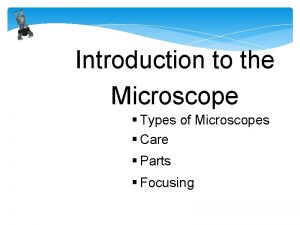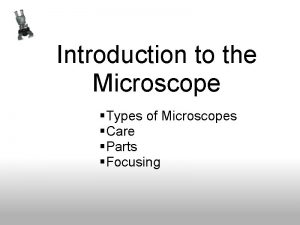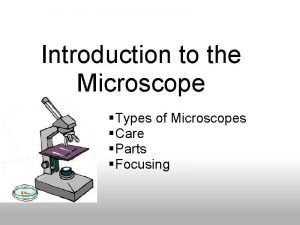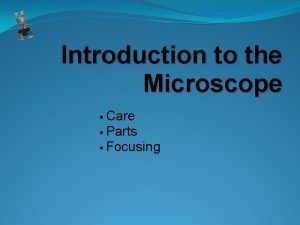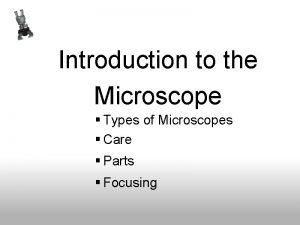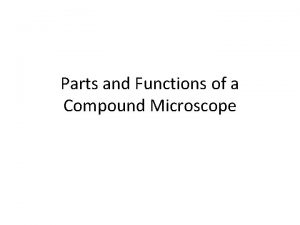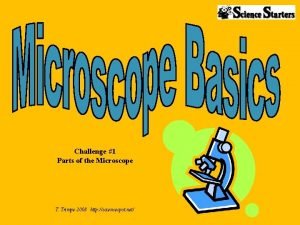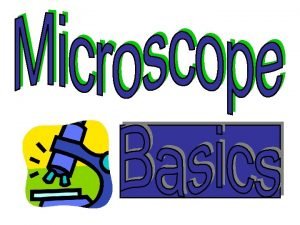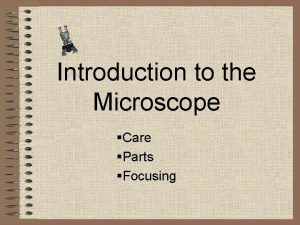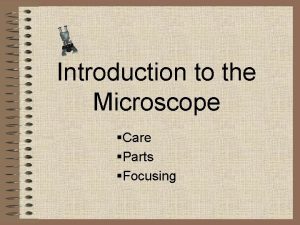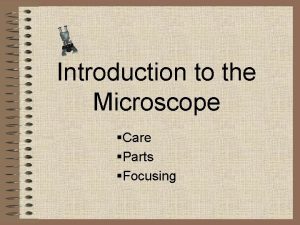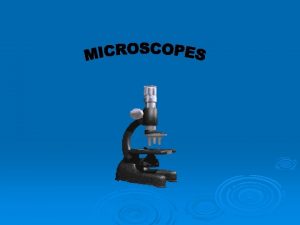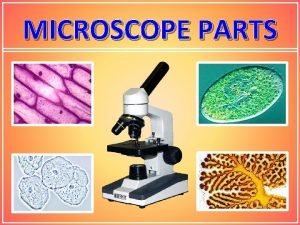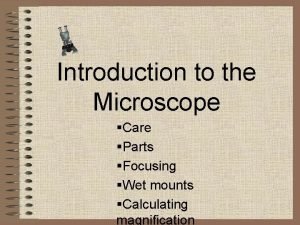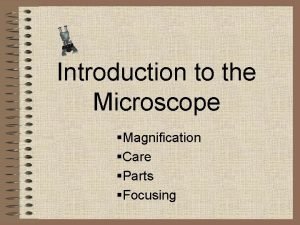Introduction to the Microscope Care Parts Focusing Always










- Slides: 10

Introduction to the Microscope §Care §Parts §Focusing

• • • Always carry with 2 hands Only use lens paper for cleaning Do not force knobs Always store covered Keep objects clear of desk and cords

Eyepiece Body Tube Revolving Nosepiece Objective Lens Stage Clips Diaphragm Light Arm Stage Coarse Focus Fine Focus Base

Magnification • Your microscope has 3 magnifications: Scanning, Low and High. Each objective will have written the magnification. In addition to this, the ocular lens (eyepiece) has a magnification. The total magnification is the ocular mag. x objective mag. Magnifica tion Ocular lens 4 x 10 x Total Magnification 40 x Low Power 10 x 100 x High Power 40 x 10 x 400 x Scanning

What’s my power? To calculate the power of magnification, multiply the power of the ocular lens by the power of the objective. What are the powers of magnification for each of the objectives we have on our microscopes? Fill in the table on your worksheet.

Comparing Powers of Magnification We can see better details with higher the powers of magnification, but we cannot see as much of the image. Which of these images would be viewed at a higher power of magnification?

• • Follow steps to focus using low power Click the nosepiece to the longest objective Do NOT use the Coarse Focusing Knob Use the Fine Focus Knob to bring the slide into focus. What can you find on your slide?

• Place the Slide on the Microscope • Use Stage Clips • Click Nosepiece to the lowest (shortest) setting • Look into the Eyepiece • Use the Coarse Focus

Let’s give it a try. . . 1 – Turn on the microscope and then rotate the nosepiece to click the red-banded objective into place. 2 – Place a slide on the stage and secure it using the stage clips. Use the coarse adjustment knob (large knob) to get it the image into view and then use the fine adjustment knob (small knob) to make it clearer. 3 – Once you have the image in view, rotate the nosepiece to view it under different powers. Draw what you see on your worksheet! Be careful with the largest objective! Sometimes there is not enough room and you will not be able to use it! 4 – When you are done, turn off the microscope and put up the slides you used.

Body Tube Nosepiece Objectives Ocular lens (Eyepiece) Arm Stage Clips Diaphragm Light Coarse Adjustment Fine Adjustment Base Always carry a microscope with one hand holding the arm and one hand under the base.
 When focusing a specimen you should always start with the
When focusing a specimen you should always start with the When focusing a specimen you should always start with the
When focusing a specimen you should always start with the When focusing a specimen, you should always start with the
When focusing a specimen, you should always start with the When focusing a specimen you should always start with the
When focusing a specimen you should always start with the Three types of microscope
Three types of microscope Parts of a compound light microscope and their functions
Parts of a compound light microscope and their functions Primary secondary and tertiary care
Primary secondary and tertiary care Difference between light microscope and electron microscope
Difference between light microscope and electron microscope Microscope mania compound light microscope
Microscope mania compound light microscope Always carry the microscope with
Always carry the microscope with Always low prices always
Always low prices always
